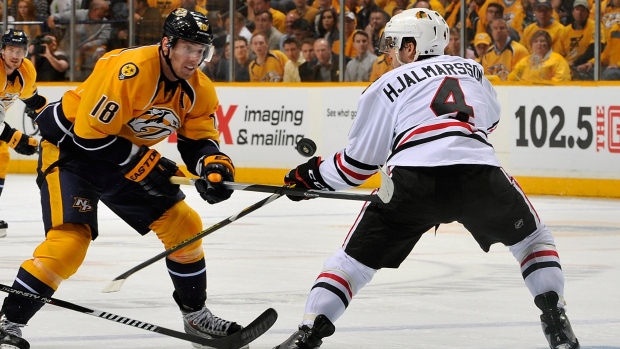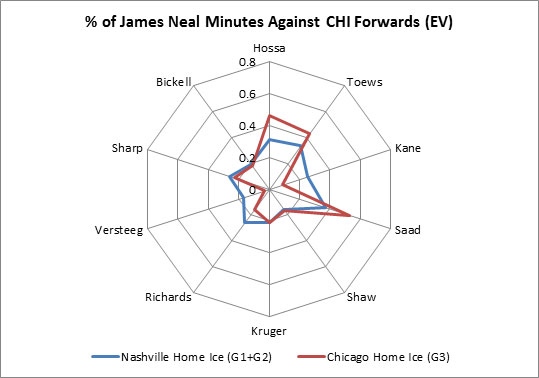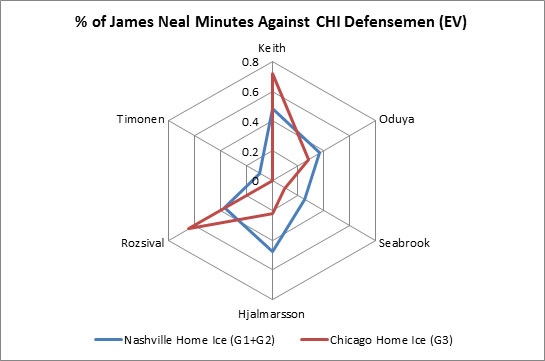Apr 21, 2015
Blackhawks changes shut down Neal
The Chicago Blackhawks used home-ice in Game Three of their series against Nashville to alter how they handled Nashville Predators winger James Neal and, Travis Yost says, the results were striking.
By Travis Yost

Despite splitting the first two games of the series in Nashville, it didn’t appear that Chicago coach Joel Quenneville was thrilled with his team’s performance. Part of that was probably because the Blackhawks dropped Game Two by a score of 6-2, where the team ended up conceding five even-strength goals.
What’s probably most amazing about Nashville’s six-goal Game Two performance (and nine goals total) is that Chicago was able to hold James Neal pointless. Neal, of course, has become one of the NHL’s premier goal-scorers. His per-60 rates sit inside of the top ten league-wide over the past four seasons, sandwiched between talent like Jonathan Toews, Vladimir Tarasenko, and Alexander Ovechkin.
Neal’s lack of scoring in games one and two wasn’t from lack of effort or performance, mind you. Neal had twelve shot-attempts over the first two games at even-strength alone, five of those coming from the home plate area. A large part of this stemmed from the fact that Neal and his linemates spent a significant chunk of ice-time in the offensive zone – Neal and teammates controlled 60% of play on the ice (earning 53% of the scoring chances). As you would expect, Neal’s individual and on-ice numbers were either best or near-best, and breakthrough seemed imminent.
I was curious to see if Joel Quenneville would change anything up against the James Neal group (which had been a mixture of Colin Wilson, Matt Cullen, and Filip Forsberg) in game three, especially since now the power of last change sat with the Blackhawks. After all, you can only give a career 12.2% shooter so many chances before he burns you.
So, did anything change? First, let’s look at the forwards.

The axis indicates the percentage of minutes James Neal saw against the player in question. There’s obviously a bit of a change here – James Neal lost some minutes against the likes of Kris Versteeg and Brad Richards, and gained some minutes against the likes of Marian Hossa (gulp), Jonathan Toews (double gulp), and Brandon Saad (triple gulp). In Game Three, Neal saw about one of every two shifts against that group – a tough ask for anyone in today’s NHL.
Now, let’s look at Chicago’s defensemen. How were they depoyed against James Neal, et al.?

This change is more radical – James Neal lost a swath of minutes against Niklas Hjalmarsson and Brent Seabrook, and a sliver of minutes against Johnny Oduya. And in exchange, he played 71% of his shifts against the Duncan Keith pairing.
It seems reasonably clear that Joel Quenneville wanted to suppress the Neal line’s goal-scoring prowess by beating them back into the defensive zone, forcing them to log extra off-puck minutes in front of Pekka Rinne. The same, probably, can be said for Nashville’s top-pairing of Roman Josi and the puck-moving defensemen behind him.
So, the big question: did Chicago’s subtle change in deployment end with results? At the most rudimentary level, yes – Chicago won 4-2, and again kept James Neal off of the scoresheet.
But, away from goal-scoring, how did James Neal look? Were his underlying numbers impressive as they were in games one and two, or did Chicago manage to beat Nashville’s best scorer into playing extensive defensive zone minutes?
JAMES NEAL - TALE OF TWO CITIES
|
|
Game 1+2 |
Game 3 |
|---|---|---|
|
Individual Scoring Chances |
5 |
0 |
|
Individual Shot Attempts |
12 |
0 |
|
Goal% |
50.0% |
0.0% |
|
ScoringChance% |
53.0% |
28.5% |
|
Corsi% |
60.0% |
28.0% |
That is as decisive and one-sided a victory as you will see in today’s NHL. Neal was a complete non-factor, as were linemates Colin Wilson and Matt Cullen.
Give credit to Joel Quenneville here: he made the most of last change, got the matchups he wanted, and the Toews group+Keith group ran roughshod over Nashville’s toughs.
Your move, Coach Laviolette.


